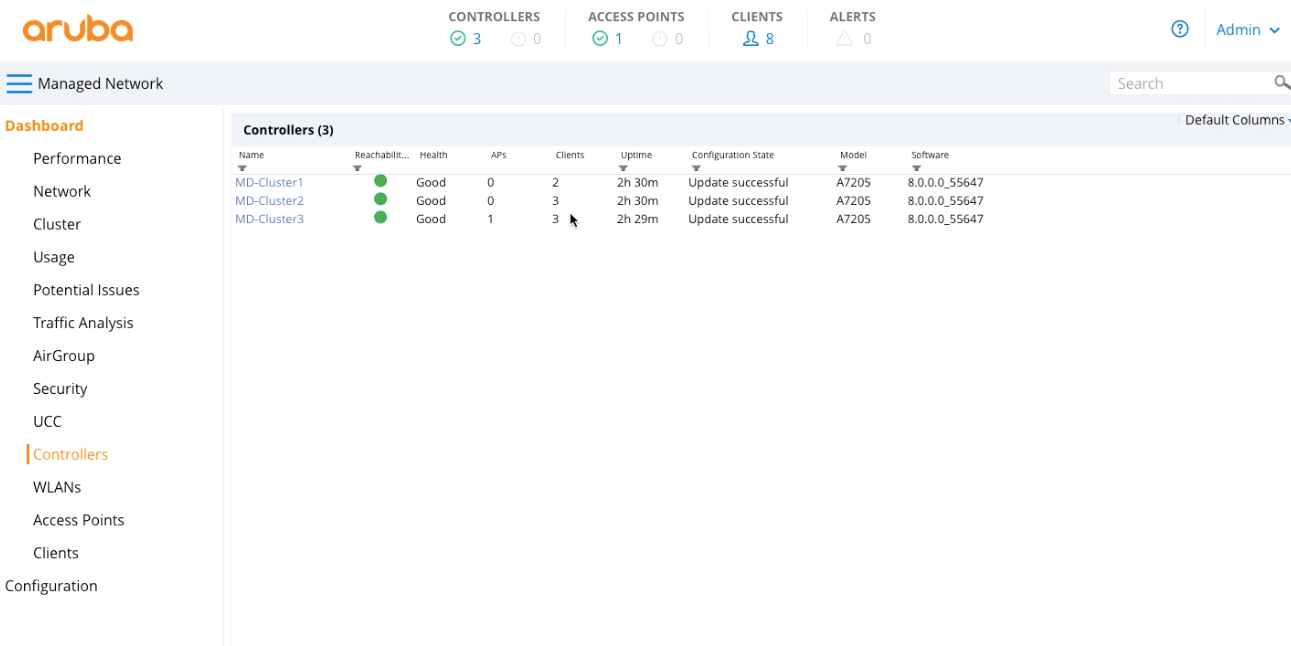This is the second in a series of blogs on ArubaOS 8. As a recap, ArubaOS 8, is the new version of Aruba's networking OS that unleashes the power of Aruba infrastructure with the latest technology to accelerate adoption of mobile and IoT.
Benefits of ArubaOS 8 include:
- Simplicity with the new hierarchical configuration and modernized UI
- Flexible deployment with new virtual options for Mobility Conductor and Mobility Controllers
- Unprecedented WLAN user experience
- Wireless that tunes itself to the users to deliver better experience
I have already covered the first two benefits in my previous blog, ArubaOS8, the backbone of the Aruba Mobile First Platform. This time, we will focus on an always-on network architecture providing unprecedented reliability and user experience.
How can we have an always-on network? What if there is a lost connection in your network core?
The answer is yes with Controller Clustering in the Aruba Mobility Conductor. We all know that massive traffic is hitting the network from mobile devices, IoT, and business critical applications. But we expect no interruption in our mobile experience if a connection or network node goes down.
If I am on a Skype call with a customer and in the middle of my call a controller fails, I should not notice any change in my wireless experience. Nor should a doctor who is visiting a patient have difficulty accessing his patient's information if a controller fails. Just think how catastrophic it could be if we have controller failure in a financial service!
Controller Clustering provides this hitless failover by clustering up to 12 Mobility Controllers, in an unlikely event of a controller failure. User session information is shared across controllers in the cluster to ensure there is not a single point of failure for any user.
Just take a look at below video where we are showing you how Controller Clustering works.
The other benefit of Controller Clustering is automatic user load balancing in crowded areas where Access Points (AP) can get overloaded. So this way, as a user we always have a good user experience. If you can see below all 8 clients are distributed evenly among all 3 controllers even when we only have one access point.

Figure 1: Clients are load balanced across cluster of controllers
Have you noticed when you are on a Skype call and start walking from one building to another, you might hear some glitches or lost audio? With Controller Clustering we can offer seamless roaming where all the controllers in a cluster work together and users can roam around the campus without getting a new IP address or re-authenticate. This can be designed for up to 10,000 APs, so you'll never feel any delay in the voice service you are using. Now let's look at another great feature that is enabled in Mobility Conductor.
Still a good mobile experience in a dense lecture hall or a conference?
Last week I attended a conference in Europe. It was packed with people. I had to contact one of my teammates for a customer meeting, but no luck with Wi-Fi Calling nor Skype. I could hardly check my emails let alone take a call. I am sure you've encountered this problem many times in crowded areas. So how can we solve this issue?
AirMatch is a new feature in the Mobility Conductor that collects RF information, such as client density, AP neighbors and interference sources from all the access points in the network and optimizes itself for better RF management in noisy high-density environments.
So what's the difference between Aruba Adaptive Radio Management and AirMatch?
Well, Adaptive Radio Management adjusts the RF environment to ensure the best radio connection and QoS for the access points. ARM makes its channel and power planning decisions locally at the AP level without having visibility of the entire network. But in high-density environments such as at my conference, static channel assignments are not enough. With AirMatch, information about how many users, channel, channel width and power of each AP is sent to the Mobility Conductor to manage optimal channels, channel widths, and power assignments across the network. This level of network control is performed automatically to maximize capacity across the entire Wi-Fi network. With the optimal assignments of channel, channel widths and transmit power, AirMatch enables:
- Even distribution of radios across available channels reducing interference while maximizing system capacity.
- Dynamic bandwidth adjustments between 20MHz, 40MHz and 80MHz to match the density of your environment which is a pretty unique feature. When the number of devices increases, the channel width is automatically adjusted to a narrower channel like 40MHz or 20MHz.
- Best coverage and even power (EIRP Equivalent Isotropically Radiated Power) distributions for seamless roaming.
So for example, if suddenly a lecture hall which usually hosts 200 students, becomes filled with over 800 students due to an event or popular lecture, AirMatch can dynamically adjust the channel bandwidth to reduce congestion, moving everyone from 40MHz channels to 20MHz channels. Or if an access point goes down and not emitting any power, the rest of the access points can adjust their power level to fill that dead zone in the network.
If you are interested to know more about ArubaOS 8 features, please visit this page. Just remember mobility, IoT and mobile applications makes us productive and efficient as long as we receive a good user experience!




